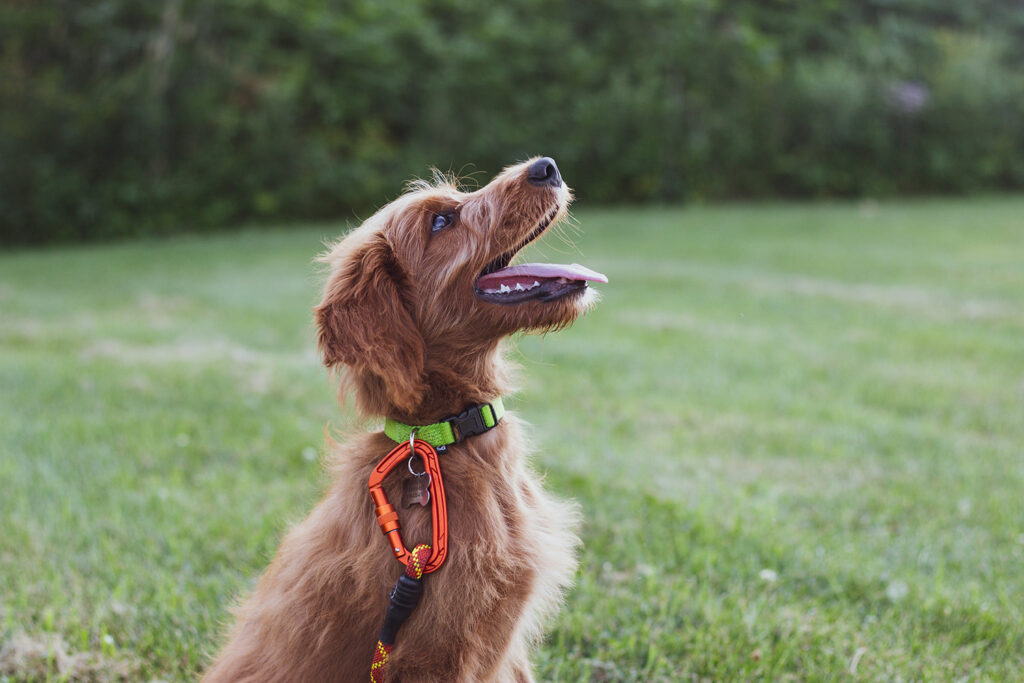I’ve been training dogs for long enough to know one thing for certain. No two dogs are the same, and no two households are the same either.
I’ve worked with dogs who wouldn’t hurt a fly but could pull you down the street like a runaway train. I’ve helped families whose neighbors had reached the end of their patience with constant barking. I’ve met dogs who guarded their food bowls like treasure chests and others who shook with fear at the sound of the vacuum cleaner.
Many of these dogs had already been through group dog training classes. Some had even been through more than one course. Their owners arrived frustrated, confused, and a little sceptical, wondering why the training “didn’t work.”
That’s where 1-on-1 home dog training often makes all the difference.
The Problem with Group Classes
Group dog training can be great for socialization and basic commands. I’ve run them myself and seen plenty of happy success stories. But they aren’t the perfect fit for every dog or every behavioural problem.
When you put a group of ten dogs together in the same space, you create a highly stimulating environment. There are sights, sounds, smells and distractions at every turn. For some dogs, this is a chance to thrive. For others, it’s completely overwhelming.
If your dog’s main issue is pulling on the lead, barking at strangers, or feeling anxious around other dogs, a class full of strange people and dogs might make those problems worse. You can’t press pause in a group setting to deal with your dog’s meltdown. You can’t get thirty minutes of uninterrupted focus on your dog’s unique triggers.
In a class, the dog trainer has to divide their attention between every participant. That means you get general guidance rather than a step-by-step plan built for your dog’s quirks and habits.
Why Home Dog Training Works Differently
When I step into your home for a training session, everything changes. Your dog is in their own space. They aren’t competing with other dogs for attention. They aren’t distracted by the smell of fifteen different treats coming from every direction.
We can get straight to the root of the problem without all the background noise. I can see your dog’s behaviour where it actually happens, in the living room, the backyard, or on your regular walking route. This is important because dogs don’t generalise well. A dog who can “sit” perfectly in a sterile training hall might act like they’ve never heard the word when the postman comes to the door.
By working in your home, we can address behaviour exactly where it happens and in the moments it happens. That makes the training more relevant and more likely to stick.
Tailored to Your Dog, Not the Average Dog
Every dog has a story. Some have had rough starts in life. Others have never left the safety of their backyard. Some are overflowing with confidence, while others are skittish and unsure.
When I work with a dog one-on-one, I’m not delivering a standardised course. I’m designing a program for your dog. If your Labrador pulls so hard you’ve started avoiding walks, we’ll focus on lead manners. If your rescue dog freezes in fear when visitors arrive, we’ll build confidence step-by-step.
Some of the most common issues I deal with in home dog training include:
- Aggression towards people or other dogs
- Anxiety and fear-based behavior
- Pulling on the lead
- Excessive barking
- Digging up the garden
- Resource guarding
Each of these requires a different approach, and sometimes even a different pace. In a group class, you might be forced to move on to “Lesson 3” even if your dog hasn’t fully grasped Lesson 1. At home, we move at the speed your dog needs, not the speed the schedule dictates.
Addressing Behaviour at the Source
A big advantage of home dog training is being able to see your dog’s triggers in real time.
If your dog barks endlessly at the front window, we can work right there on that behaviour. If your dog guards their food bowl, we can practise mealtime routines in your actual kitchen.
This level of specificity just isn’t possible in a hall with ten other dogs. Behaviour is context-driven. The environment matters. And often, changing the behaviour means adjusting something in the home as much as working with the dog. That could be a simple change in routine, a tweak to how visitors enter, or a new strategy for walks in busy areas.
Helping You as Much as Your Dog
One of the most overlooked parts of dog training is the human side. I’m not just teaching your dog, I’m teaching you how to read them, respond to them, and guide them through challenges.
In a group class, it’s hard to stop and work with you individually if you’re struggling with a technique. In a home session, we can take as much time as we need to go over handling skills, leash techniques, and timing your rewards.
I can also answer all the little questions you might not get a chance to ask in a group setting. Things like:
- What should I do when the doorbell rings?
- How do I stop my dog from chewing shoes?
- What’s the best way to tire them out indoors?
This personalized coaching helps you feel confident and consistent, which is essential for your dog’s progress.
Dealing with Difficult Cases
Some dogs simply don’t belong in a group setting, at least not yet.
If your dog has a history of aggression, high anxiety, or fear reactivity, throwing them into a room full of other dogs can be unfair and unsafe. They need a controlled environment where we can work on desensitisation and counter-conditioning without constant overstimulation.
I’ve seen dogs who once lunged and growled at every passing dog learn to walk calmly in public through a gradual, customised process. It starts at home, where they feel secure, and builds up to real-world scenarios at their own pace.
Making Progress Stick
The biggest frustration I hear from owners who have done group dog training is that their dog did well in class but quickly fell back into old habits at home.
That’s because behaviours need to be reinforced in the environment where they’ll actually be used. If your dog learns “stay” in a quiet hall, that’s great, but it won’t mean much when the kids are running around the lounge room unless we practise it there.
Home dog training creates muscle memory where it counts. We teach your dog the rules of your world, not just the rules of a training room.
Confidence for the Whole Household
Behavioural problems don’t just affect the owner. They affect everyone in the household. If your dog jumps on guests, it’s embarrassing. If they bark every time a leaf blows past the window, it’s stressful for the whole family.
By working in your home, I can involve everyone in the training process. That means the kids learn how to interact respectfully with the dog. Visitors know the greeting routine. Everyone is on the same page with commands and boundaries.
This consistency makes your dog’s progress faster and more reliable.
From Chaos to Calm
I’ve seen it so many times, the owner who starts a session feeling frazzled, embarrassed, and unsure, and ends it with a genuine smile because they’ve finally seen their dog listen.
That transformation is why I believe so strongly in 1-on-1 home dog training. It’s not about quick fixes or gimmicks. It’s about creating real understanding between you and your dog, in the environment where you live your life together.
Is It Right for You?
If you’ve already tried group dog training without success, or if your dog’s behaviour is making daily life difficult, home training is worth serious consideration.
It’s tailored. It’s focused. And it’s designed to work where it matters most, at home, in your yard, and on your walks.
The results often come faster because we remove distractions, address the root cause of behaviour, and give you the tools to maintain progress long after I’ve left.
The Takeaway
Group dog training has its place, and for many dogs it’s a fantastic start. But if you’ve reached the end of your patience, if your dog’s behaviour is straining your relationships with neighbours, family, or friends, it’s time to try a different approach.
1-on-1 home dog training meets your dog exactly where they are, both physically and emotionally. It turns training into a personal, focused experience that addresses the issues holding you back. And in many cases, it’s the turning point between frustration and a calm, enjoyable life with your dog.






